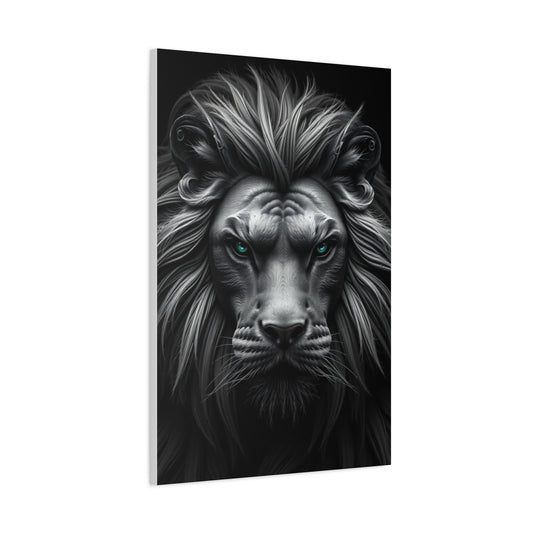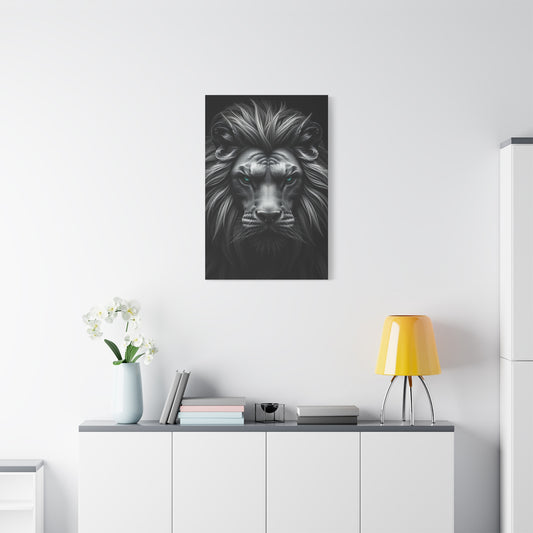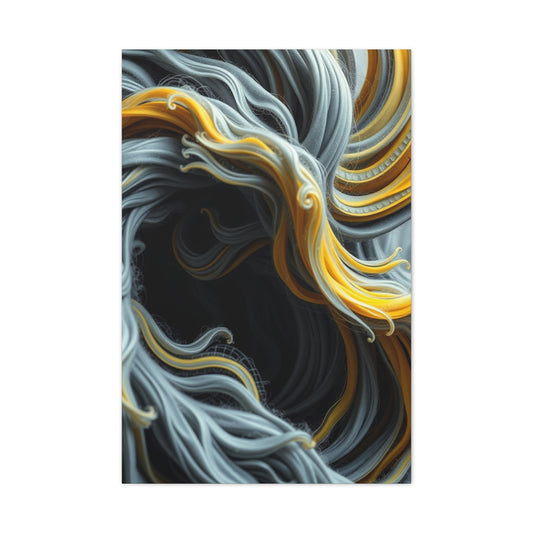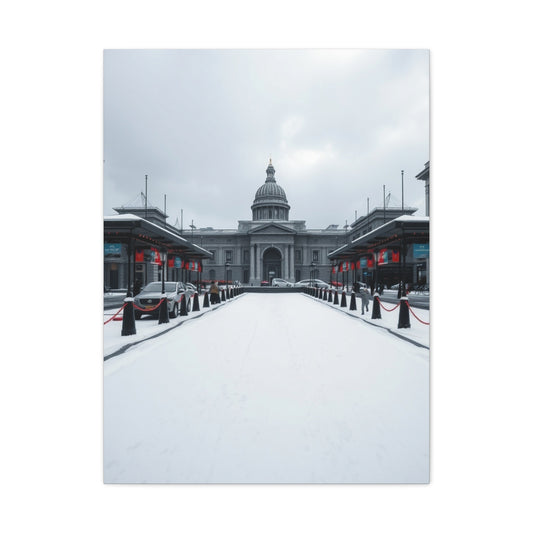Bedrooms are more than places of rest; they are sanctuaries that reflect personality and style. Through art, color, texture, and scale, walls become transformative elements rather than blank surfaces. This series explored diverse ideas, from subtle accents to oversized statement pieces, showing how creativity can merge with tranquility to create bedrooms that feel both deeply personal and visually inspiring.
Understanding the Role of Shapes in Wall Décor
Shapes carry immense weight in the world of design. In a bedroom, where serenity and comfort are vital, the form of wall art can dictate the mood of the space. Rectangles, squares, hexagons, and elongated panels all convey different feelings. While a square may suggest balance and simplicity, a panoramic stretch often reflects openness and continuity. The art of selecting shapes lies not only in aesthetics but also in the psychological effect they leave behind. Choosing correctly ensures harmony between the wall and the furnishings.
The Classic Single Panel
A single-panel artwork remains one of the most timeless choices. It is straightforward yet impactful, able to command attention without requiring companions. A rectangular panel positioned above a bed can anchor the entire room, drawing the eye toward a central focus. Squares, on the other hand, add equilibrium, particularly in symmetrical bedrooms where matching furniture pieces sit on either side of the bed. This type of shape works well for calm environments because it reduces visual clutter and allows the artwork itself to shine.
|
Related Catagories: |
Vertical Expressions
Vertical canvases are rising in popularity, especially for smaller rooms. By emphasizing height, they elongate walls and create the illusion of taller ceilings. Placing two slim vertical pieces side by side introduces rhythm while keeping the composition sleek. Bedrooms with narrow sections of blank wall benefit from these elongated panels, as they fill awkward spaces without overwhelming them. When paired with minimalist furniture, vertical pieces feel modern yet refined.
The Panoramic Spread
Panoramic artworks often mimic the sweep of a landscape or city skyline. This horizontal shape naturally expands the room’s appearance, making spaces feel broader and more open. Over a headboard or long dresser, a panoramic piece mirrors the length of the furniture, ensuring proportional flow. Soft-toned panoramas can establish tranquility, while bold, abstract versions can bring dramatic flair. They are especially effective in wide bedrooms where walls may otherwise appear bare and disconnected.
Exploring Triptychs
Triptychs, or three-panel designs, introduce balance and rhythm to a wall. Each segment carries its own weight yet remains part of a greater whole. In a bedroom, a triptych above the bed instantly becomes a centerpiece. The separation of panels adds breathing room, which can be visually soothing. This method of division works well for artwork depicting continuous landscapes, abstract movements, or thematic storytelling. Aligning the gaps evenly maintains structure, ensuring the design feels intentional rather than fragmented.
Five-Panel Symmetry
For those seeking boldness with order, a five-panel arrangement offers both. When hung symmetrically, this layout creates a grand display that extends across a significant portion of the wall. The middle panel often acts as the anchor, while the surrounding pieces provide balance. In bedrooms with large, uninterrupted walls, this approach fills space elegantly without feeling overwhelming. Five-panel sets can reflect geometric precision, appealing to individuals who enjoy meticulously arranged décor.
Wave and Flow Patterns
Multi-panel art doesn’t always need symmetry. Four-panel wave designs break from tradition by staggering panels at different heights. This layout introduces movement, making the wall feel alive. Bedrooms that crave energy and fluidity can benefit from this flowing composition. The panels need not carry identical designs; complementary colors and themes are enough to unite the wave. Such arrangements work particularly well in contemporary or eclectic spaces where variety is embraced.
Hexagonal Adventures
Unconventional shapes like hexagons bring a playful dimension to bedroom walls. A collection of hexagonal pieces can be arranged in honeycomb patterns, spreading outward in organic ways. This approach balances creativity with structure, echoing natural forms while remaining geometric. Hexagons encourage experimentation; they can be clustered tightly or scattered loosely for contrasting effects. In a child’s or teenager’s bedroom, they add dynamism, while in an adult’s room, they offer a striking departure from traditional formats.
Round and Oval Statements
Though less common, circular and oval pieces offer softness rarely found in other shapes. Their absence of sharp edges promotes calmness, perfect for a restful environment. A large circular mirror or artwork positioned above the bed becomes an instant focal point. Smaller circles, arranged in clusters, provide gentle rhythm without rigidity. These shapes pair beautifully with rounded furniture, upholstered headboards, or curved lamps, reinforcing a cohesive design language.
Layering Multiple Shapes
The most compelling bedroom walls often blend different forms. For instance, pairing a large rectangular canvas with smaller circular prints adds variety while keeping balance intact. Layering shapes prevents monotony and reflects individuality. Careful placement is key: irregular positioning can create tension, while deliberate spacing maintains harmony. Experimentation with asymmetry, such as a central rectangular piece flanked by uneven clusters, results in a distinctive composition that avoids predictability.
Aligning Shapes With Furniture
Furniture placement heavily influences how wall art shapes are perceived. A tall wardrobe benefits from nearby vertical artwork to echo its height, while a wide dresser feels more grounded when paired with horizontal shapes. The alignment of furniture and art should complement rather than compete. For example, a square canvas over a round bedside table creates an intriguing contrast, while a panoramic piece over a king-size bed reinforces proportion. Considering these relationships ensures cohesion throughout the bedroom.
The Psychology of Geometric Choices
Shapes affect human emotions subtly yet profoundly. Rectangles and squares suggest reliability and structure, which can calm the mind after a long day. Triangles or angular forms often feel dynamic, injecting energy into the environment. Circles and ovals project unity and softness, reducing stress. Understanding this psychology allows for intentional decisions that match the desired mood. In restful areas, softer shapes may be preferred, while in vibrant spaces, bold angular layouts might feel more appropriate.
Color Interaction With Shape
The impact of shape is magnified when paired with the right colors. A circular artwork in soft pastels can evoke serenity, while the same shape in striking hues may create vibrancy. Rectangular panels in neutral shades emphasize order, while multi-panel hexagons with varied tones highlight playfulness. Color and shape together form a language of design that influences the atmosphere more strongly than either element alone. This synergy makes thoughtful selection essential.
Using Negative Space Effectively
The gaps between artworks, known as negative space, are just as important as the shapes themselves. Leaving breathing room around each piece allows the eyes to rest, preventing the wall from feeling overcrowded. The wider the negative space, the more significant each piece appears. In symmetrical layouts like triptychs or five-panel designs, evenly distributed negative space enhances the sense of order. For organic arrangements like hexagons, irregular spacing can create vibrancy while still maintaining cohesion.
Cultural Influences on Shape Selection
Different cultures hold varied associations with shapes. In some traditions, circular forms symbolize eternity and continuity, making them meaningful for bedrooms where intimacy and connection are emphasized. Rectangular forms dominate in Western interiors due to their alignment with architectural structure, while hexagons resonate in cultures that celebrate patterns found in nature. Acknowledging these symbolic meanings adds depth to design choices, infusing the bedroom with more than mere decoration.
Mixing Art With Functional Shapes
Not all wall features need to be purely decorative. Shelves, shadow boxes, and geometric wall planters carry shape into functional design. When combined with artwork, these elements create layered walls that balance beauty with utility. For instance, floating shelves arranged in a triangular pattern can hold books or trinkets while echoing artistic forms. In bedrooms with limited space, functional shapes offer practicality without sacrificing aesthetic richness.
Temporary and Modular Layouts
For individuals who enjoy change, modular shapes are ideal. Removable wall panels, stick-on hexagons, or lightweight framed canvases allow for frequent rearrangement. This flexibility ensures the wall can evolve with shifting moods or seasonal décor. Unlike fixed installations, modular arrangements invite experimentation, helping residents discover new compositions that keep the bedroom fresh. This approach suits creative personalities who thrive on transformation and adaptability.
Creating Illusion Through Shape
Strategically chosen shapes can alter perception of room dimensions. Horizontal panels visually widen compact rooms, while vertical designs lift low ceilings. Large circular pieces can soften angular architecture, making boxy spaces feel less rigid. Combining shapes in deliberate ways can mask imperfections such as uneven walls or awkward corners. The illusionary power of form becomes a tool for enhancing not only style but also spatial comfort.
The Future of Shape in Bedroom Décor
As interior design continues to evolve, shapes in wall décor are expanding beyond the traditional. Digital art frames that shift images introduce fluidity, while three-dimensional panels blur the line between sculpture and painting. Innovative materials like acrylics and metals lend crisp edges to familiar shapes, refreshing classic ideas. Bedrooms will increasingly become spaces where artistic geometry blends with personal expression, ensuring that the walls reflect both individuality and design innovation.
The Importance of Scale in Bedroom Design
Scale is one of the most vital elements in bedroom wall decoration. Choosing artwork that is too small or too large for a wall can throw off the balance of the entire space. Properly scaled art not only enhances the appearance of the bedroom but also strengthens the visual relationship between walls, furniture, and architectural features. A sense of proportion ensures that every element feels deliberate rather than accidental.
Measuring Wall Space Effectively
Before purchasing or hanging any wall art, it is crucial to measure the available area. The usable space should exclude moldings, doorframes, and nearby furniture that might interfere with visibility. A good rule of thumb is to have artwork occupy around two-thirds of the visible wall span. For instance, if the open section of wall measures nine feet across, the combined artwork width should be between six and seven feet. This calculation prevents the common mistake of undersized décor that looks lost against a broad surface.
Artwork Above the Bed
The wall above the bed is one of the most significant surfaces in a bedroom. The width of the headboard often dictates how wide the artwork should be. Ideally, the piece or grouping should cover approximately two-thirds to three-quarters of the headboard’s width. For a queen-size bed that spans five feet, a canvas between three and a half to four feet wide feels well-balanced. Taller pieces may extend upward, but they should never overwhelm the sleeping area by stretching beyond the height of the headboard by too much.
Pairing Art With Dressers and Chests
Dressers and chests of drawers provide another opportunity for wall art placement. In these scenarios, the artwork should complement the width of the furniture without dominating it. A horizontal piece or a symmetrical grouping works well above longer dressers, while vertical pieces can bring balance to narrower chests. By matching the dimensions proportionally, the art appears as a natural extension of the furniture rather than an isolated decoration.
Creating Balance Over Nightstands
Nightstands, though small, often benefit from carefully chosen wall pieces. Instead of overwhelming these compact areas with oversized art, a single small canvas or framed photograph can create intimacy. Alternatively, stacking two or three petite frames in a vertical line can elongate the wall subtly. Since nightstands are often paired, keeping the art symmetrical on both sides of the bed ensures harmony. In asymmetrical bedrooms, however, a solitary piece above one nightstand can introduce a touch of uniqueness.
Considering Ceiling Height
Ceiling height plays a major role in determining artwork proportions. In rooms with low ceilings, horizontal art can broaden the room visually, making it feel more spacious. Tall, narrow pieces might accentuate the lack of height, creating discomfort rather than elegance. In contrast, bedrooms with soaring ceilings can handle vertical artworks that emphasize the sense of grandeur. Large-scale installations or tall mirrors can highlight the vertical expanse, preventing the space from feeling hollow.
Groupings and Collages
When arranging multiple pieces, proportion becomes even more critical. The combined dimensions of the grouping should adhere to the same guidelines as single artworks. For example, a gallery wall above a bed should still span two-thirds of the headboard’s width, even if it contains numerous smaller pieces. Leaving consistent spacing between frames ensures the collection reads as one cohesive unit rather than a disorganized cluster. Balance is maintained by aligning central pieces with the focal furniture, creating a unified composition.
Negative Space as a Design Tool
Empty wall areas, often referred to as negative space, are just as essential as the art itself. Overcrowding walls with oversized or excessive artwork can make a room feel chaotic. Allowing breathing room around each piece highlights its importance and prevents visual strain. Designers often recommend leaving several inches of space between frames in a grouping and ensuring margins exist between the artwork and the edges of furniture. This careful distribution of empty space cultivates an atmosphere of calmness.
Eye-Level Placement
Artwork placement at eye level is a widely accepted design principle. In bedrooms, where most activities occur while sitting or lying down, the definition of “eye level” shifts. Instead of hanging art at the standing eye level used in living rooms, pieces in bedrooms often look best slightly lower. Centering the artwork approximately 55 to 60 inches from the floor generally works, but adjustments should be made based on furniture height and the user’s vantage point from the bed.
Symmetry Versus Asymmetry
Symmetry introduces order and predictability, which many people find soothing in a bedroom. Centering a large piece above the bed or flanking it with identical artworks creates harmony. However, asymmetry can also be effective, especially in modern or eclectic bedrooms. For example, one large piece on one side of the wall balanced by smaller artworks on the other side can generate visual interest without chaos. The key lies in maintaining overall balance, even if the arrangement itself is unconventional.
Oversized Artwork and Proportion
Large-scale pieces bring drama but must be handled with care. If too wide or tall for the wall, they can overpower the room. Ideally, oversized art should serve as the primary focal point, with minimal competing decorations nearby. For instance, a vast canvas above the bed should not be crowded by numerous smaller frames. Allowing it to stand alone gives it the authority it deserves. Bedrooms with expansive walls particularly benefit from oversized art, which fills the void effectively.
Using Multiple Mediums Together
Artworks need not all be framed paintings or photographs. Sculptural elements, fabric hangings, and wall-mounted ceramics can diversify the wall while following the same proportional rules. When mixing mediums, the visual weight of each piece should be considered. A textured wall hanging may appear heavier than a framed sketch, even if both are the same size. Balancing visual weight with proportional guidelines ensures that the combination feels intentional.
Lighting and Its Relationship to Size
Proper lighting enhances proportion by ensuring artwork is visible without glare or shadows. Small pieces require focused light to prevent them from disappearing into the background, while larger pieces benefit from broader illumination. Wall-mounted sconces or overhead track lighting can be positioned to emphasize the size and shape of the artwork. Without proper lighting, even well-scaled art may fail to achieve the desired impact.
Scale in Minimalist Bedrooms
Minimalist bedrooms demand particular attention to scale, since fewer decorative elements are present. A single piece of art becomes the focal point, so it must be sized correctly. Too small, and it will feel insignificant; too large, and it may overwhelm the serene atmosphere. In such settings, proportion acts as the bridge between simplicity and visual appeal. A well-measured canvas, mirror, or textile installation can elevate minimalism into refined elegance.
Adjusting Proportion in Small Bedrooms
Small bedrooms require creative thinking when it comes to proportion. Narrow walls benefit from vertical pieces that elongate the room, while short walls can carry horizontal artworks that suggest greater breadth. Multipurpose art, such as mirrors that also reflect light, can expand the perception of space while serving as decoration. Keeping artwork closer to furniture rather than scattering it across the room prevents fragmentation, ensuring the space feels cohesive.
The Role of Frame Thickness
Frames, often overlooked, also influence proportion. A thick, ornate frame can make a small piece appear larger and heavier, while a thin, simple frame can soften the presence of a large artwork. Matching frame thickness to the scale of the wall and furniture helps maintain proportional balance. For example, a heavy wooden frame may suit a wide dresser but overwhelm a delicate nightstand. Selecting frames that complement both the artwork and its environment reinforces proportion.
Height Variations for Layered Effects
Hanging artwork at varying heights introduces depth and rhythm to a wall. A combination of higher and lower placements can draw the eye upward and downward, making the wall more dynamic. However, careful calculation is necessary to avoid disarray. Aligning the central axis of each group with the main furniture piece helps anchor the composition. This technique works well in eclectic bedrooms where variety is celebrated but order is still desired.
Proportion Across the Entire Room
Proportion is not confined to a single wall but should extend throughout the bedroom. If one wall features oversized art, the opposite wall might benefit from smaller, subtler pieces to maintain equilibrium. Balance across the room ensures that no single area feels overbearing. A holistic approach considers all walls as part of one visual narrative, where size and placement work together to establish continuity.
Future Trends in Proportional Art
Design trends are moving toward adaptable art systems that allow resizing and repositioning. Digital frames capable of displaying changing images offer the flexibility to adjust perceived scale. Modular wall installations that can expand or contract provide proportional control tailored to evolving needs. These innovations highlight the growing recognition of proportion as a key element in design, ensuring that future bedrooms can adapt seamlessly to shifting aesthetics.
The Allure of Gallery Walls in Bedrooms
Gallery walls have become a captivating feature in modern interiors. Unlike single artworks, they provide the opportunity to weave together multiple stories, themes, and textures within one cohesive arrangement. In bedrooms, where individuality and intimacy reign, a gallery wall offers a chance to display personal expression while adding vibrancy to blank surfaces. The layered visual impact makes them more than just decorative; they embody personality, history, and mood.
Choosing a Theme for Cohesion
The foundation of a successful gallery wall is a unifying theme. Without it, the arrangement risks appearing disorganized. Themes can be subtle or overt: a series of botanical illustrations, a blend of black-and-white photographs, or abstract works tied together by a shared color scheme. Establishing this guiding principle ensures that, despite varied pieces, the wall feels intentional. The theme can reflect personal interests, travel experiences, or even seasonal moods, giving the bedroom depth and identity.
Mixing Different Mediums
Gallery walls shine brightest when they include a mix of mediums. Photographs, sketches, paintings, and even small three-dimensional objects can coexist to create intrigue. For instance, a cluster of canvases may be punctuated by a metal sculpture or a woven textile framed neatly. Combining mediums prevents monotony and invites exploration. Each piece contributes a different tactile quality, which enriches the overall experience of the wall. Bedrooms particularly benefit from these layers, as they evoke warmth and creativity.
Framing as an Element of Style
Frames play a crucial role in gallery walls, acting as visual anchors. Uniform frames in a single finish, such as matte black or light wood, create unity, ideal for minimalist bedrooms. Alternatively, an eclectic mix of frames—ornate, rustic, or metallic—adds charm to bohemian spaces. The thickness and texture of frames also contribute to balance; thinner profiles highlight the art itself, while chunkier frames add substance. When carefully selected, frames transform disparate works into a harmonious composition.
Layout Planning and Spacing
Effective layout design is the backbone of a gallery wall. Symmetrical arrangements radiate order, while asymmetrical ones bring spontaneity. Consistent spacing between frames ensures coherence regardless of alignment. Designers often suggest leaving two to three inches between pieces for breathing room. Sketching the layout on paper or using removable templates on the wall helps visualize the arrangement before committing to nails or hooks. Meticulous planning avoids clutter and ensures the final display enhances rather than overwhelms the room.
Anchoring With a Central Piece
A common technique in collage-style arrangements is to designate one piece as the anchor. This central work provides focus and grounds the rest of the collection. Whether it’s a large painting, a striking photograph, or a mirror, the anchor becomes the heart of the gallery wall. Surrounding artworks then radiate outward in a balanced manner. Bedrooms especially benefit from this method above beds or dressers, where the anchor ties together furniture and décor.
Storytelling Through Arrangement
Gallery walls can function as narratives. By arranging artworks chronologically or thematically, the wall becomes a visual storybook. For example, travel photographs can trace a journey across continents, while a series of abstract pieces may depict the evolution of an artistic style. Storytelling arrangements add emotional resonance to bedrooms, turning them into sanctuaries filled with memories or inspirations. Unlike random assortments, curated narratives offer continuity and meaning that elevate the room’s character.
Incorporating Personal Memorabilia
Gallery walls in bedrooms need not rely solely on purchased art. Personal memorabilia, such as handwritten letters, postcards, ticket stubs, or pressed flowers, can be framed and included. These pieces infuse authenticity and sentiment into the space. When blended with professional artwork or photography, personal items stand out as heartfelt accents. The juxtaposition between polished and intimate pieces makes the gallery wall uniquely personal and impossible to replicate.
Playing With Color Palettes
Color coordination is vital to preventing chaos in collage-style arrangements. A monochromatic palette creates sophistication, while bold, contrasting colors evoke energy. Soft, muted tones lend tranquility suitable for restful spaces. The palette need not match precisely; even varied hues can coexist if they share undertones. Repetition of certain shades across different artworks ties them together. For example, a series of abstracts with recurring blues harmonizes with photographs featuring ocean landscapes. This subtle repetition ensures visual cohesion.
Symmetrical Gallery Walls
Symmetry provides a timeless sense of balance. In bedrooms, symmetrical gallery walls often appear above the headboard, where order enhances relaxation. Matching frame sizes arranged in grids or mirrored layouts establish structure. This approach suits minimalist or contemporary interiors, where precision is prized. The symmetry can be softened with muted colors and delicate artwork to prevent rigidity, creating a blend of structure and calmness that nurtures serenity in the bedroom.
Asymmetrical Gallery Walls
For those who crave individuality, asymmetry provides freedom. Asymmetrical arrangements allow artworks of different sizes, shapes, and orientations to coexist dynamically. They are best suited to eclectic, bohemian, or artistic bedrooms where uniformity takes a backseat to creativity. The key to success lies in balance; a large piece on one side may be offset by several smaller works on the other. Despite irregularity, the composition should still feel deliberate, not haphazard.
Vertical Versus Horizontal Orientation
Orientation influences the rhythm of a gallery wall. Vertical arrangements draw the eye upward, emphasizing ceiling height and elongating walls. Horizontal layouts, on the other hand, stretch the perception of width, complementing long headboards or expansive dressers. Bedrooms with limited dimensions can benefit from these directional illusions, using orientation strategically to counter architectural limitations. Mixing both orientations within one wall creates complexity while maintaining flow.
Integrating Mirrors Into Collage Walls
Mirrors seamlessly blend into gallery walls while adding functional value. They reflect light, making small bedrooms feel larger and brighter. Placed among artwork, mirrors break up visual monotony and introduce variety. A round mirror surrounded by rectangular frames, for example, softens geometry and adds elegance. Mirrors also provide practical benefits for daily routines, merging aesthetics with utility. Their reflective quality brings depth, making the collage more interactive.
Seasonal Rotations and Flexibility
One of the strengths of gallery walls is their adaptability. Pieces can be rotated seasonally, reflecting shifting moods and atmospheres. Lighter, airy works in spring can be replaced by cozy, warm-toned art in winter. This rotation prevents stagnation and allows the bedroom to evolve. Flexible hanging systems, such as ledges or clipboards, make swaps easier, encouraging experimentation without permanent commitment. This adaptability keeps the wall alive and engaging year-round.
Using Textures for Depth
Flat images alone may lack dimension. Incorporating textured elements, such as woven baskets, macramé hangings, or carved wooden plaques, introduces tactile richness. Textures make the gallery wall more dynamic, engaging both sight and touch. In bedrooms, where comfort is paramount, these elements add coziness. Mixing smooth photographs with rugged textiles or glossy prints with matte drawings ensures depth and variety, preventing the display from appearing one-dimensional.
Incorporating Typography and Quotes
Typography can enhance gallery walls by introducing words that inspire or soothe. Elegant calligraphy, minimalist block letters, or vintage-style prints can convey messages of motivation or tranquility. When interspersed among images, text pieces break visual monotony and add narrative weight. In bedrooms, phrases that encourage relaxation, reflection, or positivity reinforce the room’s role as a sanctuary. Typography provides a balance between imagery and verbal meaning, enriching the wall’s diversity.
Lighting the Gallery Wall
Proper lighting elevates collage-style displays. Adjustable wall sconces, picture lights, or even string lights highlight individual pieces and create mood. Dim lighting softens the collection for a calming evening atmosphere, while brighter illumination emphasizes detail. In bedrooms, layered lighting ensures flexibility; art can glow gently at night or stand out during the day. Lighting also emphasizes textures and frames, ensuring no piece is overlooked.
Small-Space Solutions
Even compact bedrooms can accommodate gallery walls. Narrow strips of wall space can host vertical arrangements of petite frames. Corner gallery walls, where two surfaces meet, make use of overlooked areas while adding charm. For renters, removable adhesive hooks allow temporary arrangements without damage. Small-scale gallery walls prove that impactful displays do not require vast expanses, only thoughtful curation and placement.
The Future of Collage-Style Walls
As design evolves, gallery walls continue to adapt. Digital frames that cycle through images provide endless variation without consuming additional space. Modular panels allow quick rearrangements, satisfying those who crave frequent change. Mixed-reality projections may soon become part of gallery walls, merging physical and digital art. Regardless of technological advances, the essence of collage-style walls remains the same: they celebrate individuality, creativity, and the intimate stories of those who inhabit the space.
The Timeless Appeal of Textiles in Bedroom Design
Fabric has been woven into human history not only for practical use but also for beauty and storytelling. When introduced into bedrooms as wall décor, textiles enrich the space with softness, pattern, and cultural resonance. Unlike framed art, which often feels rigid, textiles offer flexibility, movement, and tactility. They can transform cold walls into warm backdrops, enhancing comfort while showcasing artistry. Whether through intricate weaves, hand-dyed patterns, or bold embroidery, fabric-based wall décor carries with it a sense of heritage and craftsmanship.
Historical Roots of Textile Wall Art
Throughout centuries, tapestries and fabrics have served as more than decoration. Medieval castles displayed grand woven pieces not only as art but also as insulation against chill stone walls. In many cultures, fabrics were symbolic, depicting myths, legends, or significant events. In Eastern traditions, intricately embroidered panels often carried religious or spiritual meaning. By incorporating textiles into modern bedrooms, homeowners tap into this deep historical lineage, connecting contemporary design with ancestral storytelling.
Tapestries as Centerpieces
Tapestries are among the most striking textile options for bedroom walls. Their scale, texture, and artistry make them powerful statement pieces. A large tapestry hung above a bed can serve as a headboard substitute, anchoring the room visually. Smaller pieces can be layered together for a curated effect. Their woven nature adds depth and richness that cannot be replicated by flat prints. Designs may range from medieval-inspired patterns to abstract contemporary motifs, making them versatile for different aesthetics.
Cultural Narratives in Fabric Art
Textile wall décor often carries cultural significance. Persian rugs, Indian block prints, or Moroccan kilims each represent regional artistry and traditions. Displaying such textiles in bedrooms not only adds color and pattern but also honors diverse heritages. These pieces can act as reminders of travel, ancestry, or appreciation of global craftsmanship. Incorporating culturally rooted fabrics allows for authenticity while introducing rare and distinctive beauty into intimate spaces.
Techniques That Elevate Textile Design
Different textile techniques produce varying visual effects. Hand-dyed batik fabrics create organic patterns filled with spontaneity, while embroidery offers precision and tactile intricacy. Patchwork, quilted panels, or appliqué introduce a layered effect, combining multiple textures and hues. Macramé, with its knotted designs, provides sculptural interest while retaining softness. Each technique speaks a different language of artistry, enabling homeowners to select pieces that resonate with their own style and sensibility.
Framing and Displaying Fabric Pieces
Although textiles can be hung freely, framing them often adds structure and polish. A richly patterned scarf placed in a shadow box, or a fragment of vintage fabric behind glass, turns delicate textiles into preserved art. Frames protect fabrics from dust and damage, while allowing them to blend seamlessly with traditional art displays. Alternatively, free-hanging textiles create a relaxed, organic look. Both approaches can be used strategically depending on whether elegance or casual charm is desired.
Headboard Alternatives With Textiles
In many bedrooms, fabric-based décor functions as an alternative to traditional headboards. A draped quilt or tapestry hung at bed height creates a soft, inviting backdrop. Unlike rigid wooden or upholstered headboards, textiles offer flexibility and can be changed seasonally. This approach suits renters or those who appreciate frequent design updates. The headboard effect grounds the bed while providing artistic detail, transforming the focal point of the room with ease.
Enhancing Acoustics With Fabric Walls
Beyond aesthetics, textiles influence the acoustics of a room. Hard surfaces often reflect sound, creating echoes that feel harsh. Fabrics absorb these reverberations, making bedrooms quieter and more serene. A tapestry above the bed, or fabric panels placed strategically, can soften sound while simultaneously adding beauty. This dual function enhances comfort, creating an environment conducive to relaxation and sleep. Few decorative elements balance form and function as effectively as fabric-based art.
Color and Pattern in Textile Choices
The selection of color and pattern plays a central role in how textiles affect bedroom atmospheres. Muted, neutral fabrics bring calm and subtlety, ideal for restful retreats. Bold colors and intricate patterns inject energy and vibrancy. Repeating motifs across different fabric pieces can create cohesion, while mixing patterns encourages eclectic charm. A bedroom dominated by solid tones benefits from a patterned textile wall hanging, which injects life without overwhelming the overall palette.
Seasonal Adaptability of Fabrics
One of the most practical features of fabric wall décor is its seasonal adaptability. Heavy, warm-toned textiles suit colder months, while lighter, breezier fabrics bring freshness in summer. Changing textiles with the seasons revitalizes the bedroom without significant cost or effort. This adaptability ensures the space never feels stagnant, instead reflecting the natural rhythms of the year while maintaining harmony with the room’s function.
|
Related Catagories: |
Mixing Textiles With Other Materials
Textiles harmonize beautifully with other wall décor elements. A fabric hanging paired with wooden accents emphasizes warmth, while combining textiles with metallics adds sophistication. For instance, a macramé piece framed by brass sconces elevates casual boho design into refined artistry. Incorporating glass or ceramic alongside fabrics introduces contrasting textures that heighten interest. The interplay between soft and hard materials enriches the visual experience, making walls dynamic rather than one-dimensional.
Macramé as Sculptural Fabric Art
Macramé deserves special mention within textile décor. Its knotted technique creates dimensional patterns that appear almost sculptural. Large macramé pieces function as statement art above beds, while smaller ones can be grouped together for layered charm. The tactile quality of macramé lends coziness, and its neutral tones integrate effortlessly into varied bedroom styles. It bridges the gap between textile softness and architectural presence, giving walls structure without rigidity.
Quilted Panels and Handmade Touches
Quilts, long associated with domestic comfort, bring a handmade spirit to bedroom walls. Hanging quilted panels showcases intricate stitching and color combinations, often with nostalgic value. Family heirlooms or artisan-made quilts double as functional art pieces, blending craftsmanship with decoration. Quilted wall hangings radiate warmth, making them particularly well-suited for spaces where coziness and intimacy are prioritized. Their layered surfaces capture light and shadow, enriching visual texture.
Sustainable and Ethical Fabric Décor
The rise of sustainable design has made ethically sourced textiles increasingly important. Handwoven fabrics from local artisans or recycled materials emphasize mindful living. Organic cotton, hemp, or bamboo textiles reduce environmental impact while offering natural beauty. Choosing sustainable fabrics allows bedrooms to reflect personal ethics, ensuring décor choices align with values. Beyond aesthetics, these pieces tell stories of careful craftsmanship and ecological awareness, elevating the significance of design.
DIY Fabric Wall Art
Creating fabric wall décor can be a fulfilling endeavor. Stretching a favorite patterned fabric over a wooden frame, crafting patchwork panels, or dyeing fabric with natural pigments offers personal expression. DIY projects imbue the room with uniqueness, ensuring no two spaces feel identical. Bedrooms adorned with self-made pieces radiate individuality and creativity, transforming the walls into reflections of their inhabitants.
Layers and Drapery Effects
Textiles offer opportunities for layering rarely possible with traditional wall art. Draped fabrics that cascade down walls create theatrical elegance, reminiscent of stage curtains or regal chambers. Layering sheer fabrics over opaque ones introduces depth and playfulness, as light interacts differently with each material. Bedrooms with high ceilings particularly benefit from these drapery effects, as cascading textiles soften vertical expanses while amplifying drama.
Minimalist Uses of Fabric Wall Décor
Fabric art need not always be ornate or patterned. Minimalist approaches, such as plain linen panels or monochromatic weaves, provide quiet elegance. These restrained pieces highlight texture over pattern, allowing subtle shadows and folds to take center stage. Minimalist fabric décor suits bedrooms designed for serenity, where the absence of busy visuals supports tranquility. Simplicity in fabric art demonstrates that beauty often lies in restraint.
Lighting Considerations for Textile Walls
Lighting plays a transformative role in how fabrics are perceived. Soft uplighting emphasizes drapery folds, while directional spotlights highlight embroidery or weaving details. Natural light enhances sheer fabrics, causing them to glow gently during the day. Careful consideration ensures that fabrics are celebrated rather than flattened by poor illumination. Lighting choices should enhance their texture and depth, making fabric wall décor a living element that shifts with time of day.
The Enduring Relevance of Fabric in Bedroom Walls
Despite modern technological advances in décor, textiles remain timeless. Their combination of utility, artistry, and symbolism continues to make them indispensable. They soften, insulate, and beautify, while also expressing culture, craftsmanship, and individuality. In bedrooms, where comfort and personality are paramount, fabric wall décor bridges the gap between function and art. By celebrating fabric, homeowners create sanctuaries that are both visually rich and emotionally resonant.
The Transformative Role of Reflection in Bedroom Design
Reflection has long fascinated artists, architects, and designers alike. In the bedroom, mirrors and reflective surfaces serve more than functional purposes; they act as tools to manipulate space, light, and mood. The simple addition of a reflective surface can expand a compact room, brighten dim corners, or elevate the overall sense of elegance. By thoughtfully incorporating mirrors and other gleaming materials, walls transcend their flat existence and participate actively in the experience of the room.
Historical Use of Mirrors in Interiors
From ornate Venetian glass to gilded French Rococo frames, mirrors have carried an air of prestige across centuries. Royal palaces displayed vast mirrored halls that amplified grandeur through endless reflection. In Asian traditions, polished bronze or obsidian mirrors were believed to ward off negative energy. These historic applications reveal how mirrors are both practical and symbolic. Bringing such elements into a bedroom is a continuation of a lineage that associates reflection with light, clarity, and mystique.
Mirrors as Expansive Tools
One of the most common reasons to add mirrors to bedroom walls is to create the illusion of a larger space. A strategically placed mirror doubles the visual footprint of a room, making it appear more open. In small bedrooms, this technique is invaluable, as it counterbalances limitations without requiring structural alterations. Whether hung above a bed, across from a window, or used as a full-length panel, mirrors visually expand boundaries and enhance openness.
Maximizing Natural Light With Mirrors
Light is an essential ingredient in shaping the atmosphere of any bedroom. Mirrors amplify natural illumination by reflecting daylight deeper into the space. Positioning a mirror opposite or adjacent to a window allows sunlight to bounce across walls, filling areas that might otherwise remain shaded. This effect reduces reliance on artificial lighting during the day, making the room more vibrant and energizing. At night, mirrors complement soft lamps, scattering their glow and heightening the sense of warmth.
Ornate Frames as Decorative Statements
The frames that surround mirrors are equally important as the glass itself. An ornate gilded frame introduces opulence, while a rustic wooden surround suggests warmth and simplicity. Sleek metal edges evoke contemporary minimalism, whereas hand-carved designs embody craftsmanship. By choosing frames carefully, mirrors transition from utilitarian objects into art pieces in their own right. In bedrooms, where personalization is paramount, the interplay between frame style and reflective surface shapes the overall narrative of the room.
Wall-to-Wall Mirror Installations
For those who crave dramatic transformation, wall-to-wall mirrors offer bold impact. Covering an entire wall with reflective panels not only doubles visual space but also turns the room into an immersive environment. Bedrooms with such installations feel expansive, theatrical, and futuristic. Careful planning ensures that overwhelming brightness or distortion is avoided, as balance remains key. When paired with subtle furnishings, wall-to-wall mirrors allow the space itself to become the art.
Antique and Distressed Mirror Finishes
Not all reflective surfaces need to gleam with perfect clarity. Antique or distressed finishes offer depth and character. These surfaces scatter light softly, producing a gentle shimmer rather than sharp reflections. Their aged appearance introduces nostalgia and intrigue, blending well with vintage, rustic, or eclectic bedroom themes. Unlike flawless modern mirrors, distressed versions whisper stories of time and imperfection, enriching the room with a sense of history and soul.
Mirror Shapes and Their Influence
The shape of a mirror greatly influences its visual effect. Rectangular mirrors suggest order and balance, while circular ones bring softness and continuity. Oval forms elongate walls subtly, and geometric designs add playful rhythm. Grouping mirrors of varied shapes creates dynamic visual arrangements, akin to a gallery wall. In bedrooms, where every element impacts atmosphere, the choice of mirror shape contributes significantly to the emotional tone of the space.
Functional Mirrors With Artistic Presence
Bedroom mirrors often serve practical roles in daily routines, from dressing to grooming. Yet even these functional pieces can embody artistry. A full-length mirror with sculptural detailing, or a vanity mirror surrounded by delicate lights, combines purpose with design. This dual role ensures that necessity never undermines aesthetics. Instead, mirrors reinforce the balance between beauty and practicality, a defining trait of thoughtful bedroom design.
Reflective Panels and Alternative Surfaces
Beyond traditional glass, reflective panels made of metal, acrylic, or polished stone bring distinct qualities to walls. Brass panels emit warm, golden reflections, while stainless steel introduces industrial sharpness. Polished marble or granite offers subtle gleam alongside natural veining. These alternatives diversify reflective possibilities, introducing rare textures and hues into bedroom walls. Each material refracts light differently, allowing designers to curate atmospheres ranging from cozy to avant-garde.
The Power of Mirrored Furniture
Reflective surfaces are not limited to wall hangings alone. Mirrored dressers, nightstands, and wardrobes expand the language of reflection within bedrooms. Such furniture not only serves storage purposes but also interacts with light, spreading brightness across walls. When mirrored pieces are positioned near wall-mounted reflective surfaces, their combined effect multiplies depth and luminosity. This layering of reflection integrates walls and furnishings into a unified design conversation.
Mirror Placement Above the Bed
Placing a mirror above the bed requires careful consideration, as it becomes an immediate focal point. A single large mirror creates grandeur, while multiple smaller mirrors form rhythmic interest. Safety and scale are crucial factors, ensuring that the installation feels secure and proportionate. When done thoughtfully, mirrors above the bed magnify light while emphasizing the centrality of the sleeping area, making the wall more than a blank backdrop.
Symmetry and Asymmetry in Mirror Arrangements
Symmetry often fosters a sense of calm in bedroom design. Two identical mirrors flanking a headboard, or a balanced arrangement of reflective surfaces, creates order and tranquility. Asymmetrical groupings, on the other hand, inject energy and unpredictability. By experimenting with both approaches, walls can convey either serenity or playfulness. The chosen arrangement reflects not only stylistic preference but also the desired emotional atmosphere of the space.
Mirrors as Artistic Installations
When treated creatively, mirrors transcend their practical function and become pure art. Fragmented designs, mosaic mirror tiles, or mirrors combined with painted elements transform walls into interactive installations. Light bounces irregularly across these surfaces, animating the room with ever-changing reflections. Bedrooms benefit from such dynamism, as it prevents monotony while maintaining intimacy. Artful mirror arrangements blur boundaries between décor and fine art, elevating everyday surroundings into extraordinary expressions.
Integrating Mirrors With Lighting Fixtures
Pairing mirrors with lighting fixtures enhances both elements. Wall sconces reflected in mirrors double their glow, while pendant lights near reflective surfaces scatter brightness broadly. This integration produces layered illumination that shifts throughout the day. Soft candlelight mirrored against walls multiplies its warmth, crafting romantic and soothing ambiances. Such synergy ensures that mirrors do not function in isolation but collaborate with other design features to enrich atmosphere.
Ceiling Mirrors for Unique Perspectives
While less common, mirrors on ceilings offer intriguing possibilities. They expand vertical space, reflect chandeliers, or capture shifting daylight. In bedrooms with low ceilings, reflective panels overhead create a sense of loftiness. Careful moderation is necessary, as excessive ceiling mirrors risk overwhelming subtle design. However, when executed with restraint, they add unexpected depth and transform ordinary rooms into imaginative sanctuaries.
Feng Shui and Symbolic Considerations
In certain cultural philosophies, mirrors carry symbolic weight. Some traditions suggest avoiding mirrors directly opposite beds, as reflections may disrupt rest. Others emphasize their ability to deflect negative energy and invite prosperity. While interpretations vary, acknowledging symbolic dimensions of mirrors ensures that bedroom design resonates not only visually but also emotionally. For many, aligning reflective surfaces with cultural beliefs fosters deeper harmony within the space.
Sustainability in Reflective Design
Sustainable design extends to reflective surfaces as well. Reclaimed mirrors, recycled glass, or upcycled metallic panels reduce environmental impact while contributing unique character. Incorporating vintage or secondhand mirrors prevents waste while introducing rare charm unattainable in mass-produced options. Sustainable reflective design acknowledges the importance of beauty with responsibility, ensuring that walls shine not only with light but also with ethical integrity.
The Enduring Allure of Reflection in Bedrooms
Mirrors and reflective surfaces continue to captivate because they merge function with artistry. They brighten, expand, and decorate while adapting to varied styles from minimalist modern to ornate classical. More than just design tools, they represent timeless fascination with light and perception. In bedrooms, they enrich intimacy while offering practical benefits. Reflection remains an enduring medium, forever capable of turning blank walls into radiant and transformative experiences.
The Impact of Scale in Bedroom Design
Scale is one of the most powerful design principles in interiors. In bedrooms, oversized wall art transforms blank surfaces into commanding focal points. The sheer size of such pieces draws attention instantly, setting the tone for the entire room. Unlike smaller accents that blend into the background, large art introduces drama, boldness, and visual clarity. It eliminates the need for excessive décor by anchoring the space with singular presence.
Why Oversized Art Resonates
Oversized art resonates because it balances simplicity with grandeur. A single piece can carry enough visual weight to define a room, reducing the need for clutter. This approach suits modern living, where minimalism and intentional choices prevail. Large artwork emphasizes confidence, suggesting that every design decision is deliberate. Bedrooms benefit especially from this method, as oversized pieces foster calm by avoiding scattered decoration while still providing striking impact.
Statement Pieces as Emotional Anchors
Every bedroom has a story, and statement pieces often serve as its narrator. Whether it is a vast abstract canvas, a monumental photograph, or a sculptural installation, these works embody emotion and personality. Statement art can convey serenity, excitement, or introspection, depending on the subject matter. More than simple decoration, it becomes an emotional anchor that influences the mood of the entire room, guiding rest and inspiration alike.
Minimalist Drama Through Simplicity
Minimalism is frequently misunderstood as plain or sterile. In truth, minimalist drama emerges from carefully chosen elements that carry weight through simplicity. A vast monochromatic painting or a single geometric mural exemplifies this. By stripping away unnecessary detail, the artwork demands focus on texture, color, or form. In bedrooms, such pieces harmonize with uncluttered layouts, creating sanctuaries where simplicity fosters tranquility yet retains undeniable presence.
Abstract Works for Endless Interpretation
Abstract oversized art thrives in bedrooms because it allows endless interpretation. Unlike literal imagery, abstraction adapts to the viewer’s imagination, evoking different feelings at different times. Broad brushstrokes, color gradients, or layered textures shift depending on lighting and mood. Abstract art therefore remains timeless, never exhausting its ability to inspire. When scaled up, abstraction commands walls with ambiguity that stimulates contemplation without overwhelming restfulness.
Photography as Monumental Art
Photography, when printed in large formats, introduces realism and narrative into bedrooms. A sweeping landscape can bring nature indoors, while an intimate portrait establishes personal connection. Black-and-white photographs add sophistication, while color images infuse vibrancy. Large-scale photography aligns particularly well with minimalist interiors, where its clarity and detail contrast beautifully against pared-down furnishings. Bedrooms become immersive experiences when one photographic image dominates a wall with vivid storytelling.
Sculptural Wall Installations
Statement art need not be confined to canvas. Sculptural wall installations, made from wood, metal, or mixed materials, add depth and physical presence. These three-dimensional pieces project into space, creating shadow play and tactile intrigue. Their oversized scale transforms them into architectural features as much as decorative elements. In bedrooms, sculptural installations blur the line between art and structure, offering unique forms of drama that canvases cannot replicate.
Color Psychology in Large Art
Color influences emotions significantly, and when applied on a grand scale, its impact intensifies. Soft blues, greens, and neutrals in oversized art calm the senses, promoting rest. Vibrant reds, oranges, or yellows energize and invigorate. Muted earthy tones ground the room with stability. Selecting colors carefully ensures that large art aligns with the bedroom’s desired atmosphere. When spread across expansive surfaces, these hues envelop the space with psychological resonance.
Placement and Proportion Principles
The placement of oversized art determines its effectiveness. Centering a large piece above the bed anchors the focal point of the room. Aligning it with eye level ensures comfort in viewing, while leaving adequate negative space around it maintains balance. Proportion also matters—artwork should not overwhelm furniture but complement it. Measuring carefully prevents imbalance, ensuring that grandeur never devolves into cluttered dominance.
Diptychs and Triptychs as Alternatives
Oversized art does not always need to be a single panel. Diptychs and triptychs—art split into two or three sections—offer flexibility while maintaining dramatic scale. The spacing between panels introduces rhythm, allowing walls to breathe while still presenting unified imagery. Bedrooms benefit from this technique, as it distributes visual weight gracefully without diminishing impact. Multi-panel oversized art creates both cohesion and movement, striking balance between expansiveness and rhythm.
Oversized Typography and Graphic Elements
Typography, when magnified to monumental scale, becomes art in itself. A single oversized word or phrase can dominate a wall, communicating inspiration, affirmation, or playfulness. Graphic symbols or minimalist icons enlarged to striking proportions achieve similar effects. In bedrooms, such bold statements provide daily reminders of values or moods, merging language and imagery into unified expressions. Their oversized presence ensures readability while amplifying significance.
The Role of Negative Space Around Large Art
Negative space plays a vital role in amplifying oversized art. Allowing surrounding walls to remain uncluttered ensures that the piece breathes and commands focus. This principle aligns with minimalist drama, where emptiness enhances presence. In bedrooms, where rest is paramount, balancing large art with open space avoids overstimulation. The artwork then becomes both centerpiece and reprieve, embodying grandeur without crowding intimacy.
Material Exploration in Oversized Pieces
Materials contribute as much as imagery in oversized art. Canvas exudes painterly tradition, while acrylic or glass surfaces introduce sheen. Wood-backed pieces bring warmth, and metal-based art adds industrial edge. Textured surfaces like plaster or mixed media create tactile intrigue at scale. Bedrooms gain richness when oversized art incorporates unusual materials, as their impact multiplies with size. These material choices allow large art to engage both eyes and senses.
Statement Murals and Painted Walls
Murals painted directly onto bedroom walls represent the ultimate statement art. They merge architecture and creativity seamlessly, becoming permanent features of the space. Murals can depict abstract gradients, nature-inspired scenes, or geometric designs. Their oversized scale integrates fully with walls, dissolving boundaries between artwork and structure. Bedrooms with murals feel immersive, as though the very walls breathe with creativity. Unlike framed art, murals become inseparable from the identity of the room.
Minimalist Black and White Oversized Art
Black and white oversized art deserves special mention for its striking elegance. Stripped of color, focus shifts to form, contrast, and composition. Large monochromatic pieces embody sophistication, aligning with minimalist ideals while still delivering dramatic presence. Bedrooms decorated with such art exude timeless calm, as black and white transcends trends. The sheer scale of these works ensures that simplicity reads as powerful rather than plain.
Lighting Strategies for Large Pieces
Lighting plays a pivotal role in showcasing oversized art. Wall-mounted spotlights emphasize texture and detail, while indirect lighting softens impact for a more serene effect. Natural light shifts across large surfaces throughout the day, animating the artwork dynamically. Bedrooms benefit from adjustable lighting, allowing oversized pieces to adapt to morning freshness or evening calm. Correct illumination ensures that scale does not overpower but instead enhances.
Emotional Investment in Statement Art
Because of their size and dominance, oversized pieces often demand emotional investment. Choosing such art requires confidence and resonance, as it will dictate the room’s atmosphere. Homeowners often select works that reflect deep personal meaning, ensuring enduring satisfaction. Statement pieces become part of identity, outlasting trends or fleeting decoration. Bedrooms adorned with emotionally significant oversized art feel intimate, as though walls mirror the inhabitant’s inner life.
Sustainability and Large-Scale Art Practices
Sustainability extends even to oversized art. Reclaimed wood panels, recycled metals, or eco-friendly paints allow for grand scale without environmental compromise. Supporting artists who practice sustainable creation further aligns bedrooms with mindful living. Oversized art, when sustainable, demonstrates that dramatic presence can coexist with responsibility. This combination reinforces the idea that beauty and ethics enhance one another, enriching both space and conscience.
The Enduring Legacy of Grand Art in Bedrooms
Oversized art and statement pieces have timeless appeal because they unify confidence, simplicity, and drama. They command attention, define spaces, and influence emotions profoundly. Minimalist drama proves that less can indeed be more, as long as scale is leveraged intelligently. In bedrooms, where serenity and self-expression intertwine, such art offers both restfulness and grandeur. Blank walls become canvases for bold identity, forever transformed by the presence of monumental creativity.
Conclusion
The exploration of bedroom wall art across this series reveals that walls hold immense potential to shape atmosphere and identity. From the elegance of abstract murals to the boldness of oversized art, each approach balances beauty with meaning. Colors carry emotional depth, textures add tactile warmth, and scale defines presence. Together, these elements create bedrooms that extend beyond utility, evolving into personal sanctuaries of expression. The harmony between simplicity and boldness proves that even the most minimal spaces can embrace drama when curated thoughtfully. Whether guided by sustainability, emotional resonance, or aesthetic impact, wall art ensures that bedrooms reflect individuality while promoting restfulness. The enduring appeal lies in its ability to balance form with feeling, making every choice deliberate and every wall purposeful. Ultimately, bedroom art is not just decoration—it is a language of self-expression woven into the very fabric of living spaces.
























